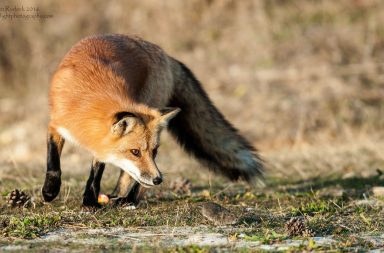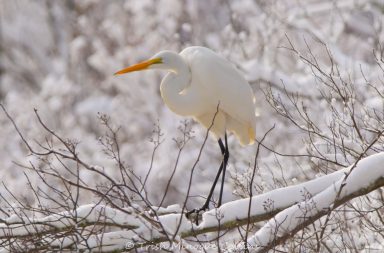BALTIMORE ORIOLE
L 7-8 in. W 111/2 in.
What a beautiful bird! Males have a black head and back and a striking brilliant orange-yellow chest. Wings are black with some white and one long white wing bar; females are duller-greenish brown on the back, dull orange-yellow on the breast. Orioles got their name from the Baron of Baltimore; Irishman George Calvert whose coat of arms is the same colors as that of the male “Baltimore orioles”.
Males arrive on territory in early May several days before the females. Their clear songs echo through the trees, and they will sing almost constantly until they mate. Generally, any singing late in the season is from unmated or immature birds. Once the female arrives a branch will be selected either near the end or closer to the trunk depending on the predators in the area. (As an example if squirrels are abundant, building the nest at the end of the branch would make it more difficult for the heavier squirrel to invade the nest.)
Oriole nests are fascinating creations. They are teardrop or gourd shaped with the “outer bowl” woven first using elastic “animal, plant, and human made fibers”. Spring like fibers becomes the next woven layer and finally softer fibers are used to line the inside of the nest. When the nest is finished the female will go to the bottom of the nest and wiggle around to settle the nest into the final shape. Nest building usually takes about one week and is built from 6 to 90 feet above ground.
Four to five eggs are laid and the incubation period is from eleven to fourteen days. The female incubates the eggs with the male in attendance; some males will feed the female as she sits on the nest. Both parents will defend the young against predators and have been known to recognize and toss out cowbird eggs.
Baby birds are born with their eyes closed and partially covered with a white down. Fledging occurs in about eleven to fourteen days with both parent birds feeding the young birds. Their diet includes caterpillars, dragonflies, grasshoppers and, where available, ripe fruit like cherries and mulberries.
Young birds resemble the adult females and the young male orioles do not achieve their adult plumage until autumn of their second year. The young begin their migration at the end of August and adult birds begin the fall migration in late July through August; they winter in Mexico and other Central American countries. Frequently, a few birds are late migrating south in the fall, and some will overwinter even in Canada, sustaining themselves at feeders.
The Baltimore Oriole range overlaps with that of the similar Bullock’s Oriole in the Midwest. Since the two species may produce fertile hybrids, they are often called the Northern Oriole in that part of the country. It is the state bird of Maryland and Maryland’s American League baseball team was named after this bird. A group of orioles are collectively known as a “pitch” and a “split” of orioles.
Orioles will come to feeding stations that have orange halves & grape jelly. You can also buy oriole feeders and a special nectar they like (they have a special tongue, which resembles a brush, for lapping up nectar).
Oriole populations appear to be fairly stable & not of conservation concern. However, they are sensitive to pesticides and, since they migrate at night, are also know to be victims of collisions with buildings & communication towers.
So, look for that flash of orange & black or listen for those clear musical notes and you can check off the Baltimore Oriole on your list. Good Birding!
Photos below contributed by members of the Long Island Wildlife Photography group on Facebook.

Heff Stoppe | Nest Building

Diane Prokop Chatterton

Kerry O’Brien Lukowski
More photos on pages 2 and 3



